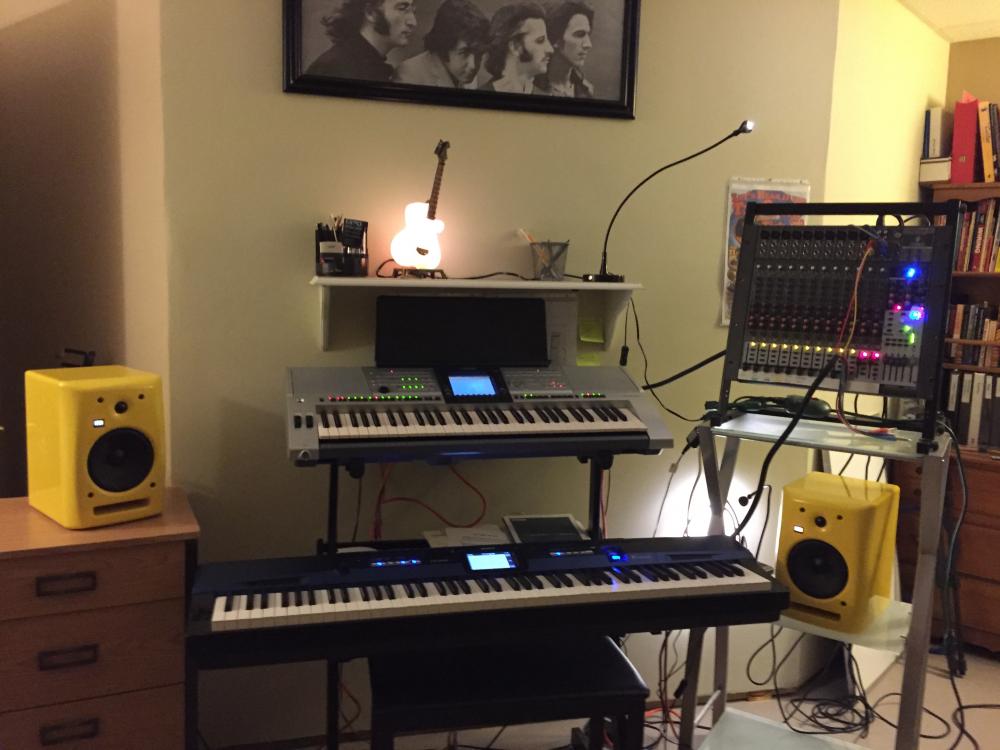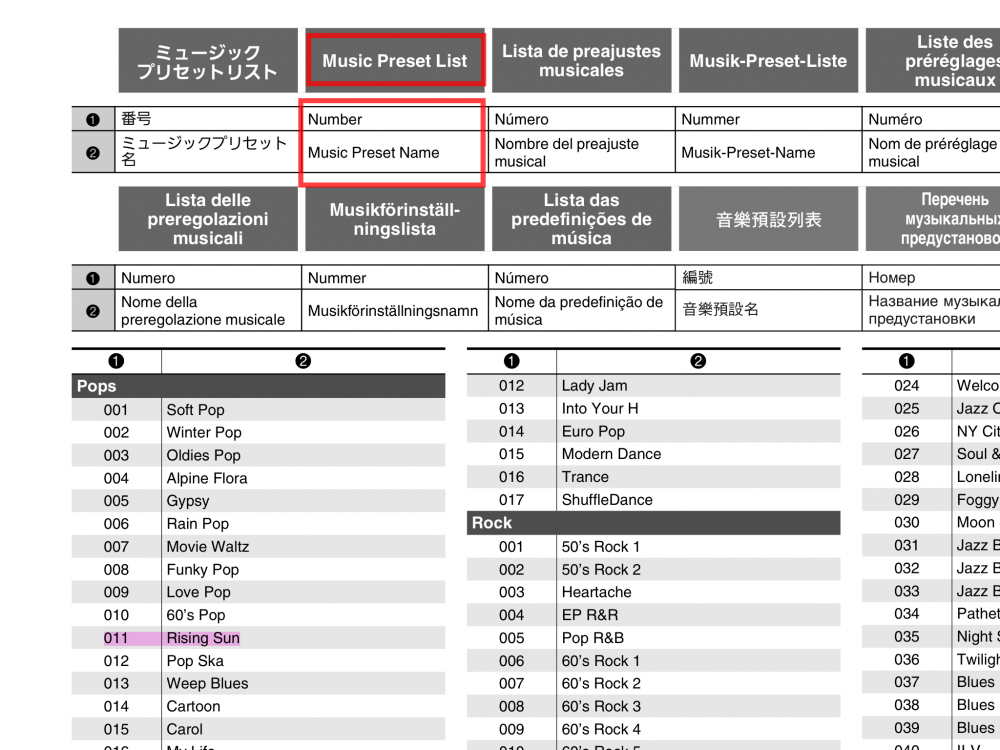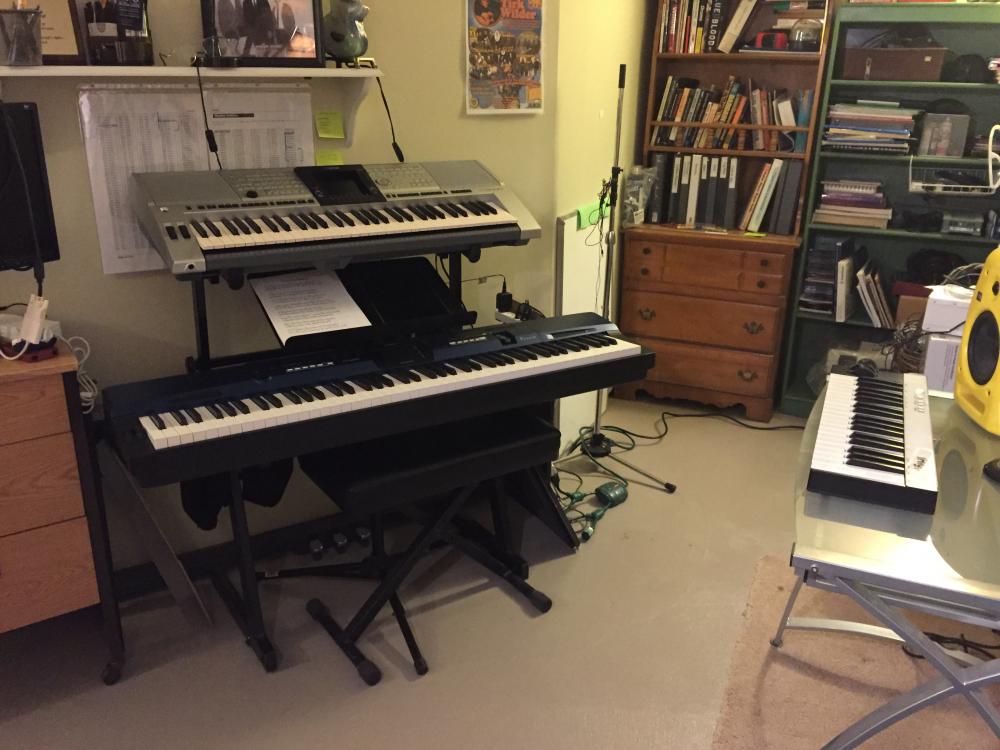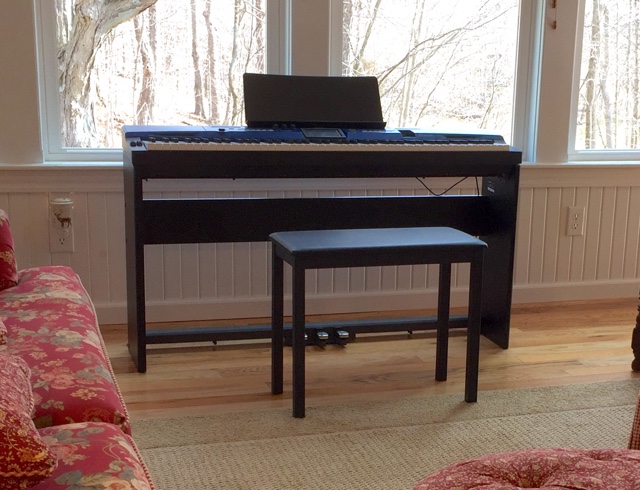
Trent
Members-
Posts
53 -
Joined
-
Last visited
Content Type
Profiles
Forums
Downloads
Everything posted by Trent
-
PX 560 buzzing sounds/vibration for E.piano and bass sounds
Trent replied to KarthikPai's topic in PX-560M
After I wrote about the issue, I made an effort to duplicate the notes which went into resonance. Nothing. I tried all notes in default grand piano, then tried most of the bass tones. Still no vibration, buzzing, or any other distortions. Everything is clean. I haven't checked low organ tones or deepest synthesizer tones, but I'm ok with what I heard last night. Now or it could be that I changed a setting like EQ, and forgot that I did it. Oh well. Love the piano tone. Also adding hex to other tones fattens up the sound -- I like that too. -
PX 560 buzzing sounds/vibration for E.piano and bass sounds
Trent replied to KarthikPai's topic in PX-560M
You probably nailed it, Jockeyman. Mine also resonates at a certain bass frequency when the volume is cranked, and I've always thought it due to cabinet resonance. Not a big problem, because these are home or practice speakers, and a house system is likely to be used if you play at larger professional size gigs; wedge monitors too. Occasionally I utilize my studio monitors, and no problems with resonance frequencies; of course. Plus, the sound emanating from the PX-560 is superb, and has no competition as far as I'm concerned. That said, I might look into beefing up the internal plastic strucure, add damping, caulk, and securely fasten the speakers. -
choosing the keys for a medley
Trent replied to Cameron MacKenzie's topic in General Casio Discussion
Cameron, that and the Beatles didn't read music. Especially when playing live. At practices, Paul might noodle on his bass and come up with nice run; then the others would start to add their thing; linking notes and chords together and singing without reference to the circle of fifths. As you, I like some theory too as I'm learning piano pieces, but some of the greatest musicians gel, jam, and get into the groove when the music springs up from the soul and takes life. http://www.ukuleleyes.com/issues/vol8/no3/feature.htm "The Music Lesson" by Victor Wooten is one such example. http://www.amazon.com/Music-Lesson-Spiritual-Search-Through/dp/0425220931 also, -
Yes. Reverb, chorus, and DSP are available to apply at the LINE IN/MIC IN inputs; and can be recorded. A MIC VOLUME knob is located near these 1/4" inputs. However, they aren't available at the AUDIO IN stereo mini-jack. That input can be used with smartphones and other music player devices. It too, has its own level control to adjust the volume and is located next to the mini-jack. Turn the volume level down when either connecting things or switching electronics; speakers should be turned on last so that the electronic pop noises don't damage them; although probably not with 12 watts. Just a precaution.
-
Nice! How did you do the drums? Also, the wah?
-
I've been experimenting with running my PX-560 into the Yamaha, and the results are rather revealing and music to my ears. Sonic delivery is much improved using the Yamaha's sound system . Now the the sound quality from my Casio Privia is on par, tit-for-tat with my yamaha. Whoot!
-
+++++ 1. I'm looking at the EX-P; When the time comes that I can not go another day without it.
-
Thanks for the tips, majnoon. I'm much closer to being able to record something suitable for this site than I was at the beginning of the year. I've never gigged nor done home studio much with keyboards, but you've given me some things to ponder as I am progressing towards that goal. Most of my instrument playing stems from 50 years of gigging as a bass player in several dozen (mostly) rock/blues bands. Starting with formal guitar lessons, then after about 6 months, playing by ear took over when I met my first band mates in 1963, at 15 years old. Chord patterns and riffs learned from records became our first method of learning; while copying other bands albums and songs. It became easier to learn new material as time progressed as we swapped licks, until finally, baseline patterns became ingrained enough to be routine. Then, magic began to happen, and creativity blossomed into original parts from within ourselves. Getting "into the groove" lifted our band, as we became a one, wholeness, instead of a group of dissimilar individuals. Carrying this into keyboard, along with other more formal technique, is the process of playing enough that it becomes comfortable; so much so that the sheet music is no longer depended on as the modus-of-operandi. If we are solo players, our developed music technique can feel the music, and it then comes from the soul. I'm not there yet, but closing in on it. As familiarity with learning a variety of songs grows, it is getting to the point that those riffs are starting to develop and becoming my own. At my age, it's taking a little more time though; but it's possible, just like the little engine who claimed; "I think I can," or whatnot. I really think I can, and I'm working to achieve it.
-
I've listened to all of the presets, and several are recognizable songs. The song names though, are not the real names, possibly due to liability issues with copyright and whatnot. I use the presets for noodling around and trying out different riffs, fills, and solo lead runs to improve my piano chops. "House of the Rising Sun" is highlighted in my attached file.
-
I enjoyed it; it's a well-played rendition of a familiar Beatles tune. You put some nice fills and riffs in between the melody lines. I'm always trying to learn from other musicians, and learning riffs is one of my items of focus. You have been a favorite pianist of mine, and an example of where I'd like to be in the future. Maybe you could help me, as I have recently started playing again. What is your method of acquiring riffs and flourishes? (Formal lessons, reading standard notation, by ear, listening to others, from media or noodling)? Also, when did you begin to learn them, and how long have you been working on them? Thanks in advance.
-
Yeah; but have you played through all the many instruments and rhythms and compared the sounds to a good baseline? My impression is that you haven't. For crying out loud, the 560 is pretty simple, logical, and straightforward. Yeah, hex layers are cool, but having good sounding default tones is important too. Most layers are built from multiple tones. Of course I bought the PX-560 a long time after downloading and studying both it and the PX-560 Appendix. I've also watched several dozen of Chuck's excellent videos, plus have watched and followed Mike's webinars also. When on this site though, I try my best not to insult owners of the 560 who are pleased. As I've said before, I'm kind of pleased with the 88-keys, and am ok with the grand concert piano tones. But the Organ, Guitar, Bass, Strings, Brass, Reed, Synth, Ethnic, Drums, and even the infamous Hex Layer tones are all lacking in sound quality. They are dead, flat, with no rich harmonics to add dimension. All of the tones sound mediocre at best when compared to Yamaha; even my old tech 2004 PSR Yamaha. My comparison baseline is an obsolete Yamaha PSR-3000 that I purchased in 2004. According to the folks on the PSR Tutorial FORUM, The latest PSR-s970 is a vastly improved product, with much better sounding voices and styles (aka tones and rhythm accompaniment). So, I have and am using a somewhat inferior old and obsoleted product, simply due to new and advanced technology. I really expected Casio to be up to par too, and be better than my Yamaha. Wow. It is NOT though! ...AND... It's by a huge margin. I'm sure that the OP has wisely sent his back by now. Keeping it for just the piano didn't seem to be in his best interest, as it is mine. I've got a superior (to my 560) sounding arranger to pull me through for the other exciting features. I'm now saving up for a PSR-970, and won't be sidetracked or sucker-punched again. But you have to admit; the 560 is good eye candy sitting underneath my 12-year old arranger. Dang, the old arranger sure sounds good -- but the 560 is a good or ok piano. Just don't dig deep or it's not so good. LOL
-
I've listened to all of the presets, and several are recognizable songs. The song names though, are not the real names, possibly due to liability issues with copyright and whatnot. I use the presets for noodling around and trying out different riffs, fills, and solo lead runs to improve my piano chops. "House of the Rising Sun" is highlighted in my attached file.
-
Who of us PX-560 owners on this board can or would consider themselves as experts on the Casio PX-560? As as for me; I'm just beginning to learn piano myself, and have only owned a 560 for less than a month. Also, keep in mind that this is primarily a users forum, and that Casio engineers and techs probably don't visit very often. Except for Mike Martin, who wears multiple hats, and is very busy in many areas within Casio. We, as PX-560 owners/users/experts are probably small in number, and even fewer have the skill sets to answer complex questions that have been asked of us. My main point is, we should proceed to build up a database of FAQ's, uploads, registrations, hex layers, and other settings ourselves. We have been given an area for uploads. Somebody's got to do it. LOL.
-
Having a USERS section or sticky on hints and tips for using the PX-560 would be beneficial also; upload area for user registrations, new songs and new styles too. We are a conglomerate of players, tinkerers, fiddlers, experimenters, and learners who may need or want either development progress ideas and data or be involved in a sharing environment. Just for point-of-interests about me, as a "new-member" intro: My interests, are currently centered on learning the keyboard half as good Chuck, of whom I have stored a great number of his youtube songs so that I can practice them on my keyboard. Others have been posting about all kinds of diverse issues pertaining to this keyboard. Although I have listened to almost all the hex layer samples, I still go right back to the default grand concert piano tone(s). The same with my arranger, I found myself gravitating to piano. However, I don't mind experimenting, but only when I've finished my chops practice. I could ramble on about myself, but hearing input from other PX-560 users is important too, and a hex layers section is a good place to start.
-
Mike uses an Mid-Audio in one of his videos. This one; I think: M-Audio - EX-P
-
I do have the pedals for my PX-560 that came bundled with my cabinet. I mostly use the sustain pedal, but have not tried to re-configure it for expression pedal; like Wah as one example. I'll work on that this weekend, if I can get around, through, or over my honey-do list. LOL BTW, how would the pedal mitigate aftertouch? Also, what would having aftertouch do to improve the PX-560? Then, how are these pedals continuous? Finally, the 560 action is fairly heavy, more so than some acoustics that I've played.
-
Bill, probably very few of us can answer you satisfactorily as we don't all approach the keyboard exactly like you do -- or like exactly like the few other folks that are here. All ten of them. (kidding, but may not be too far off). Brad answers where he can, and is probably the most well versed to answer questions here, regarding the PX-560. But he doesn't even own a PX-560, so must do double studying of the manual and comparative analysis between the PX-5s and PX-560. That said, the only way one of us could supply an answer for you, is to purchase Sonar and have a PC that would run it. I only have a Mac and GarageBand. Not quite the intense, bits and under the hood midi stuff of Sonar, which sounds very confusing. GarageBand has drum kits, drummers, and drum pads to pick and choose patterns from. I'm curious though at what you are doing and why. Are you playing the drums on your keyboard, using the keys as a pad similar to Novation or Akai and other drum pads?
-
I haven't used Sonar and can't answer your questions for that platform. My DAW experience since getting the PX-560, is only with GarageBand. Of course the PX-560 couples flawlessly with GB, since GB is so simple. My KB usage doesn't get under the hood very much, and I typically just play the dang songs in my songbooks and fake sheets. When in GB, I select a drum kit and pattern, then it does the drumming for me. Using the drum pads would be ok too. To that rythm, I play a keyboard chord progression on another track, then layer other instruments into separate tracks until the whole band is playing with me; up to 32 tracks before having to merge tracks. Provided the merged tracks are decent sounding, the process could continue till there is no longer any ideas as to where the song needs more stuff. LOL
-
A small mixer ($50-$100) can be used to divide the signals out and feed the keyboards; then send the final signal to the house mixer.
-
BTW, on the PX-560, you can select the drums only part to the accompaniment; easily. Just press the rhythm >/O* (for play/pause) or don't engage the accompaniment button. You can also pause/break and start back up again during a chord progression. Just hit the >/O* button to pause when you want the break, and hit the chord or note when you want it to start again either with or without accompaniment (or drums only if you wish). Two different drum roll breaks can be had with NORMAL/FILL-IN, and VARIATION/FILL-IN. They also provide a break of sorts during the song performance. The Yamaha arranger is a totally different animal. It IS an arranger, and NOT a piano. EDIT> (NOT TRUE)>They really are lame pianos compared to the 560. LOL A B3 organ is not a piano either. You don't want weighted keys on an organ, and the 560 will again, blow it away in the piano department. A Montage is not an arranger either. It doesn't have much in the accompaniment department, but a lot in the synth department. It may come fairly close to the 560 in piano mode, but for crying out loud. It's 3x more expensive too. Controller keyboards are quite different too. Those are best at DAW sequencing and playing VST samples. Controllers are usually cheap too. Mostly under $500, and loads of fun if you want to get under the hood. Categorizing of Keyboards is important, because while there is overlap, the various types are also quite distinct. The PX-560 is definitely not lame by any means. It is however, unique, and is extremely equal to or better than other brand pianos. You should be comparing it with the Yamaha 255, Yamaha CV, and other piano keyboards. NOT a PSR, pa3x Roland other arrangers. Casio PX-560's are not arrangers. But those keyboards that are sold as arrangers should be better at doing arrangements than a keyboard sold as a piano. It stands to reason and is only logical, because that is what they are made for. Casio PX-560's do crossover slightly into the arranger territory. Just like arrangers crossover into the piano region. Arrangers though usually have synth key action, non-weighted and less than 88-keys. Not good for a piano. As I experiment more and more, I'm finding that the rhythms and tones in the 560 aren't really that bad after all. Maybe my speakers are getting broken in. LOL But I am indeed getting to like them, and adjusting to using them to play a multitude of piano songs. *The "O" is a square icon, like a pause button. Use that button to play or pause your rhythm during a song. Oh, and that's what I got my PX-560 for; to play songs. Look out Elton John! HaHa He has nothing to worry about.
-
Anther side to this, is in particular, if an acoustic piano is wanted, but there is not room for one, then a slab electric piano may be the next best choice. They can be easily moved and put elswhere too. A big piano in the living room may become an intrusion, or even an eyesore to a non-playing spouse... and maybe the player/owner themselves would like it better in another room. In my case, I really wanted a Steinway, but settled on a PX-560 as a viable substitute for an acoustic piano. From the get-go, my priority was on achieving the best acoustic piano features and sound. I already have an arranger, and it is not an acoustic keyboard. Likewise, my electric piano is not an arranger, but it is one really good piano. My goal for an acoustic piano substitute is reached and exceeded with the Casio PX-560. The px560 is categorized by Casio as a stage piano, not an arranger. At first, however underwhelming its arranger qualities may seem, it is capable of more, much more. Prove it to yourself by listening to the demo and presets. They are convincing and realistic band sounds. So there must be a way to harness the tones and styles to create equivalent arrangements. Until then, I'm enjoying a fantastic acoustic piano experience.





